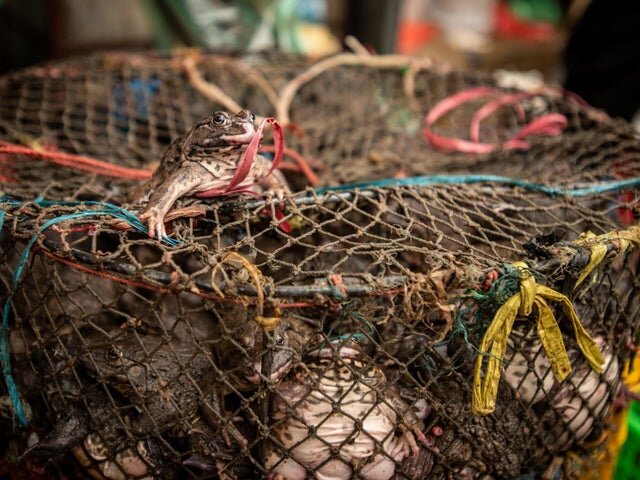
The Expanding Frog Trade
Frogs occupy a forgotten sphere of animal farming, and in doing so hide a host of startling ecological truths that reflect the wider state of mass animal agriculture.
1 Exclusive Article
with The Independent
3 locations
documented at
1-3 Billion
frogs killed
The Issue
Frog farming is often forgotten, and overlooked as just a ‘French delicacy’. In reality, anywhere between one to three billion frogs are slaughtered every year and are consumed worldwide, with huge numbers being consumed in the US and across Asia and Europe (due to complex supply chains and conflicts of interest, accurate tracking of frog harvests is challenging ).
Research shows that the huge rate of consumption is playing a role in ecosystem collapse, species extinction, and helping spread disease epidemics throughout the world. It is also causing untold suffering to the billions of frogs themselves. But despite the growth, the potential ecological impact of frog farms is often neglected and over-exploitation of wild-caught frogs is ongoing. This decline reverberates across local ecosystems, given that frogs play a pivotal role in insect population control. In regions where amphibians become targets of hunting, researchers have observed a surge in toxic pesticides.
There is no doubt that the trade in frogs’ legs for consumption is a global issue, with most countries involved in the trade as exporter, importer or some combination. Americans eat 20% of the world's frog legs, and soon the United States is likely to overtake France and Belgium as the world's largest consumer of frog legs.
The appetite for frogs has already driven species to the brink of extinction in countries from France to India, with bans on their wild capture in these countries in place. In recent decades, there have been four major source regions exporting edible frogs or body parts (wild and/or farmed): East Asia, (China and Taiwan), Southeast Asia (Indonesia and Vietnam), South Asia (India and Bangladesh).
Impact For Change:
Moving Animals have documented multiple instances of frog slaughter mainly in Vietnam, which is the second largest exporter to Europe after Indoneisa. These amphibians frequently find themselves often excluded from protective statutes, undergoing harrowing ordeals. Our investigations found that the reptiles have their snouts cut off with a cleaver or a pair of scissors, with their still-wriggling bodies being skinned. This is done in full view of other animals.
We collaborated with UK mainstream media outlet The Independent on an investigation into the trade to raise awareness of the suffering behind this overlook part of the animal agriculture industry. As part of this, we filmed thousands of frogs taken from stacked delivery crates and poured into buckets at a wholesale fish market in Vietnam. Workers rifled through the frogs by hand, before stuffing them into bags ready for sale – all while the amphibians were still alive. We also saw the mangled bodies of dead or dying frogs scattered across the market floor; frogs who managed to jump out of the tubs while being sorted ended up squashed under the feet of passers-by or under the wheels of motorbikes speeding down the warehouse corridors.
Photo Essay: Next in Line
One photograph from this investigation was part of a 5-part photo essay, ‘Next in Line’, which won the International Vegan Film Festival 2020/2021 Photo Essay Contest in the Animal Welfare & Best Overall categories.
Farmed animals endure so many acts of physical and emotional violence throughout their short lives. There is the physical suffering, such as painfully cramped conditions and the horrific slaughter process itself. And there's the emotional violence, like being forced to witness the death of others - something that many of us, as human animals, are rarely exposed to. These images portray this emotional violence as a moment in time, one where the animals watch the death of another individual, likely with the understanding that they are next in line.
HIDDEN: Animals in the Anthropocene
By Jo-Anne McArthur, Keith Wilson, We Animals Media
HIDDEN: Animals in the Anthropocene is an unflinching book of photography documenting our relationship with non-human animals in the 21st century, as depicted through the lenses of 40 award-winning photojournalists. This remarkable book was awarded first-place and gold winner in Pictures of the Year International, Independent Publisher and Prix de la Photographie Paris, and forwarded by actor Joaquin Phoenix.
Three photographs of Moving Animals' co-founder, Amy Jones, were featured in HIDDEN, including an image documented during this investigation.
Use these visuals
Visit the Animals used for food gallery on the Moving Animal archive. For related footage, please get in touch.






















